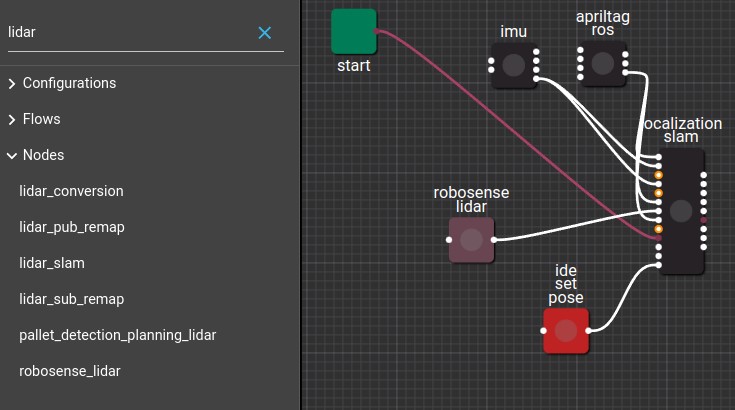
Autonomous mobile robots (or AMRs) are becoming increasingly ubiquitous in everyday life. AMRs operate autonomously 24/7 in dynamic environments, such as warehouses, ports, or grocery stores, without the need for constant human intervention. We see AMR carrying out tasks including material handling, inventory management, cleaning and maintenance, security, and agriculture. By performing the often dull, dirty, and dangerous tasks to help employees and fill labor shortages, AMRs can improve safety, sustainability, and efficiency.
MOV.AI and RoboSense have teamed up to provide manufacturers and integrators the essential tools – software and lidar – to build, deploy, and operate enterprise-grade AMRs. Together, they are changing how autonomous robots are developed, advancing time to market, scalability, and delivering flexible full-stack platforms to meet customer needs.

The homepage of MOV.AI’s IDE for developers: a library of out-of-the-box algorithms and hardware, including Robosense lidar
We spoke with Amir Alfandary, VP of product from MOV.AI to learn more about the company and how RoboSense’s lidar technology enhances their solutions.
Q. Tell me a little bit about the beginnings of MOV.AI. How did the company start?
A. Amir: MOV.AI was founded in 2016 after realizing that AMRs were stuck in the previous century – closed products that perform one predetermined task – and that the robot operating system (ROS) lacked many tools to develop and deploy AMRs that meet enterprise-grade needs.
As the MOV.AI team developed their robot, they also built ROS-based tools to make their lives easier. True to the nature of open source, they shared the tools with the ROS community. The responses they got made it clear that they weren’t the only ones challenged by the lack of tools and the ROS-based enterprise-grade Robotics Engine Platform™ was born.
Q. How are you using RoboSense’s lidar sensors in your solution?
A. Amir: MOV.AI’s platform includes a visual, ROS-based integrated development environment (IDE), a library of drag-and-drop hardware components and algorithms to enable autonomous navigation and perception. The platform offers heterogeneous fleet management software that manages a variety of AMRs simultaneously, including from different vendors, in the same physical space in addition to deployment tools.
We integrated Robosense’s Helios 16 lidar, a customizable multi-beam sensor, into MOV.AI’s software platform. The sensor is now available as part of MOV.AI's IDE drag-and-drop component library. It can be used by customers to simulate their robot’s behavior throughout development, maintaining high truth to reality, saving critical development time.
The Helios 16 data, certified by MOV.AI, can be connected directly to our autonomous navigation and perception algorithm library. It can be used out of the box for 3D-SLAM, object detection, risk prevention, and area scanning.
AMR manufacturers can use the Helios 16 with MOV.AI’s autonomous algorithm library or with their own algorithms to develop a differentiated AMR that can handle dynamic environments.
Q. Why RoboSense? What is it about their product that stands out?
A. Amir: RoboSense’s Helios 16 lidar offers the quality, reliability, and a wide vertical field of view to perfectly enhance AMR perception and localization in dynamic environments, such as warehouses. Their solution is flexible and customizable, and they offer some of the best prices in the market.
Q. Combined with RoboSense’s technology, what does MOV.AI’s solution provide that other companies cannot?
MOV.AI is unique in a couple of ways: First, we are the only solution that is built as an open platform, which means customers can use it to create their own intellectual property (IP), customize their robot software, and even create and import their own code. By delivering these capabilities, we help customers accelerate their AMR development through out-of-the-box modules with a simplified visual ROS development.
Secondly, equipped with RoboSense’s lidar, we are the only ones who provide an end-to-end platform. Our solution covers the common drivers, algorithms, behaviors, and software features needed across AMR development, deployment, and fleet management, allowing manufacturers to focus on their own differentiation.

How an MOV.AI platform user can connect RoboSense’s lidar to a SLAM algorithm for robot localization
Q. Can you tell us about a successful use case?
A. Amir: Working with Hikrobot, we were able to build an enterprise-grade AMR in just three months! Hikrobot wanted to ensure its next-generation Pallet Movers could generate value for logistics operators from day one, with no change or disruption of operations. To ensure the level of autonomy and flexibility required, they successfully developed the new robot in record time using the MOV.AI software platform, utilizing its navigation and perception algorithms. To learn more, check out the full case study.
Q. What is next for MOV.AI?
A: As the demand for MOV.AI-enabled AMRs continues to grow, we will support a larger scale of fleet size and simplify the deployment process to shorten on-site deployment time by less technical staff. We plan to deploy more of our full-stack platforms and use a broader portfolio of RoboSense sensors as we expand. It is an exciting time!

Various sensors connected to MOV.AI’s navigation and perception algorithm library
To learn more about the Helios 16 and RoboSense’s sensors, reach out to us at rsi-office@robosense.ai or fill out our contact form HERE.
To learn more about MOV.AI, visit https://www.mov.ai or info@mov.ai